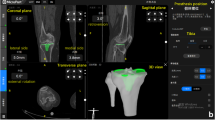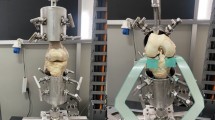Abstract
A surface-guided total knee replacement (TKR) aims to achieve close to normal kinematics through specially shaped tibiofemoral articulating surfaces. The resulting geometry of the TKR components affects the tibiofemoral contact mechanics. Therefore, evaluation of the contact characteristics of the implant is critical, as the tibiofemoral contact stress influences the short-term and long-term performance and durability of the implants. In this study, the contact behavior at the tibiofemoral articulating interface for a customized surface-guided TKR was studied. The contact area and mean contact stress at specific flexion angles were measured mechanically by pressure sensitive films to validate the outcomes from finite element analysis (FEA) under similar load conditions. Two activities of daily living were studied; lunging and squatting. As expected, FEA predicted larger contact areas at various flexion angles due to the limited sensitivity range of the pressure sensitive films. During lunging and squatting, the contact area increased as the flexion angle reached 90°, and decreased as the knee was flexed to higher angles. The mean contact pressure was less than 10 MPa at 120 degrees of flexion under squatting load. The outcomes revealed that a high range of motion can be achieved, while the mean contact pressure remains below the material limits of the tibial polyethylene insert.






Similar content being viewed by others
References
Chapman-Sheath, P., Bruce, W., Chung, W., Morberg, P., Gillies, R., & Walsh, W. (2003). In vitro assessment of proximal polyethylene contact surface areas and stresses in mobile bearing knees. Medical Engineering & Physics, 25, 437–443.
Rawlinson, J., & Bartel, D. (2002). Flat medial–lateral conformity in total knee replacements does not minimize contact stresses. Journal of Biomechanics, 35, 27–34.
Halloran, J. P., Easley, S. K., Petrella, A. J., & Rullkoetter, P. J. (2005). Comparison of deformable and elastic foundation finite element simulations for predicting knee replacement mechanics. Journal of Biomechanical Engineering, 127, 813–818.
Bartel, D., Rawlinson, J., Burstein, A., Ranawat, C., & Flynn, W., Jr. (1995). Stresses in polyethylene components of contemporary total knee replacements. Clinical Orthopaedics, 317, 76–82.
Barink, M., De Waal Malefijt, M., Celada, P., Vena, P., Van Kampen, A., & Verdonschot, N. (2008). A mechanical comparison of high-flexion and conventional total knee arthroplasty. Proceedings of the Institution of Mechanical Engineers, Part H: Journal of Engineering in Medicine, 222, 297–307.
Simpson, D., Gray, H., D’Lima, D., Murray, D., & Gill, H. (2008). The effect of bearing congruency, thickness and alignment on the stresses in unicompartmental knee replacements. Clinical Biomechanics, 23, 1148–1157.
Willing, R., & Kim, I. Y. (2009). Three dimensional shape optimization of total knee replacements for reduced wear. Structural and Multidisciplinary Optimization, 38, 405–414.
Zdero, R., Fenton, P., Rudan, J., & Bryant, J. (2001). Fuji film and ultrasound measurement of total knee arthroplasty contact areas. Journal of Arthroplasty, 16, 367–375.
D’Lima, D., Chen, P. C., & Colwell, C. W., Jr. (2001). Polyethylene contact stresses, articular congruity, and knee alignment. Clinical Orthopaedics, 392, 232–238.
Shiramizu, K., Vizesi, F., Bruce, W., Herrmann, S., & Walsh, W. R. (2009). Tibiofemoral contact areas and pressures in six high flexion knees. International Orthopaedics, 33, 403–406.
Walker, P. S. (2015). The design and pre-clinical evaluation of knee replacements for osteoarthritis. Journal of Biomechanics, 48, 742–749.
Sathasivam, S., & Walker, P. (1998). Computer model to predict subsurface damage in tibial inserts of total knees. Journal of Orthopaedic Research, 16, 564–571.
Fregly, B. J., Sawyer, W. G., Harman, M. K., & Banks, S. A. (2005). Computational wear prediction of a total knee replacement from in vivo kinematics. Journal of Biomechanics, 38, 305–314.
Godest, A., Beaugonin, M., Haug, E., Taylor, M., & Gregson, P. (2002). Simulation of a knee joint replacement during a gait cycle using explicit finite element analysis. Journal of Biomechanics, 35, 267–275.
Liau, J., Hu, C., Cheng, C., Huang, C., & Lo, W. (2001). The influence of inserting a Fuji pressure sensitive film between the tibiofemoral joint of knee prosthesis on actual contact characteristics. Clinical Biomechanics, 16, 160–166.
Pejhan, S., Bohm, E., Brandt, J., & Wyss, U. (2016). Design and virtual evaluation of a customized surface-guided knee implant. Procedings of the Institution of Mechanical Engineers, Part H: Journal of Engineering in Medicine, 230, 949–961.
Wyss, U., Amiri, S., & Cooke, T. D. V. (2010). Knee prosthesis. Patent:US20120179265.
Kurtz, S. (2009). Ultra high molecular weight polyethylene in total joint replacement and medical devices. UHMWPE Biomaterials Handbook (2nd ed.). New York: Academic Press.
Willing, R., & Kim, I. Y. (2009). A holistic numerical model to predict strain hardening and damage of UHMWPE under multiple total knee replacement kinematics and experimental validation. Journal of Biomechanics, 42, 2520–2527.
Khosravipour, I., Luo, Y., Pejhan, S., & Wyss, U. (2015). Contact stress analysis of surface guided knee implant: Proceedings of the 25th CANCAM, London. Ontario: Canada.
ASTM standard: F2083-11: Standard specifications for total knee prosthesis (2011).
Bergmann, G., Bender, A., Graichen, F., Dymke, J., Rohlmann, A., et al. (2014). Standardized loads acting in knee implants. PLoS ONE, 9, e86035.
Smith, S. M., Cockburn, R. A., Hemmerich, A., Li, R. M., & Wyss, U. P. (2008). Tibiofemoral joint contact forces and knee kinematics during squatting. Gait Posture, 27, 376–386.
Weiss, J. M., Noble, P. C., Conditt, M. A., Kohl, H. W., Roberts, S., Cook, K. F., et al. (2002). What Functional Activities are Important to Patients with Knee Replacements? Clin Orthop, 404, 172–188.
Morra, E. A., & Greenwald, A. S. (2003). Effects of walking gait on ultra-high molecular weight polyethylene damage in unicompartmental knee systems: A finite element study. Journal of Bone and Joint Surgery (American Volume), 85(4), 111–114.
Halloran, J. P., Petrella, A. J., & Rullkoetter, P. J. (2005). Explicit finite element modeling of total knee replacement mechanics. Journal of Biomechanics, 38(2), 323–331.
Khosravipour, I. (2015). Contact stress analysis of Surface guided knee implant using finite element modeling. Dissertation, University of Manitoba, Winnipeg.
International Standard Organization. (2009). Implants for surgery—wear of total knee-joint prostheses—Part 1: Loading and displacement parameters for wear-testing machines with load control and corresponding environmental conditions for test-ISO 14243–1.
Acknowledgements
This work was supported by DePuy Synthes, the University of Manitoba, and the Orthopedic Innovation Center. We are grateful for the technical support and contributions of Leah Guenther, Meaghan Coates and Lawrence Cruz at the Orthopedic Innovation Center.
Author information
Authors and Affiliations
Corresponding author
Rights and permissions
About this article
Cite this article
Pejhan, S., Khosravipour, I., Gascoyne, T. et al. Evaluation of the Tibiofemoral Contact Characteristics of a Customized Surface-Guided Knee Implant. J. Med. Biol. Eng. 39, 205–212 (2019). https://doi.org/10.1007/s40846-018-0399-5
Received:
Accepted:
Published:
Issue Date:
DOI: https://doi.org/10.1007/s40846-018-0399-5




